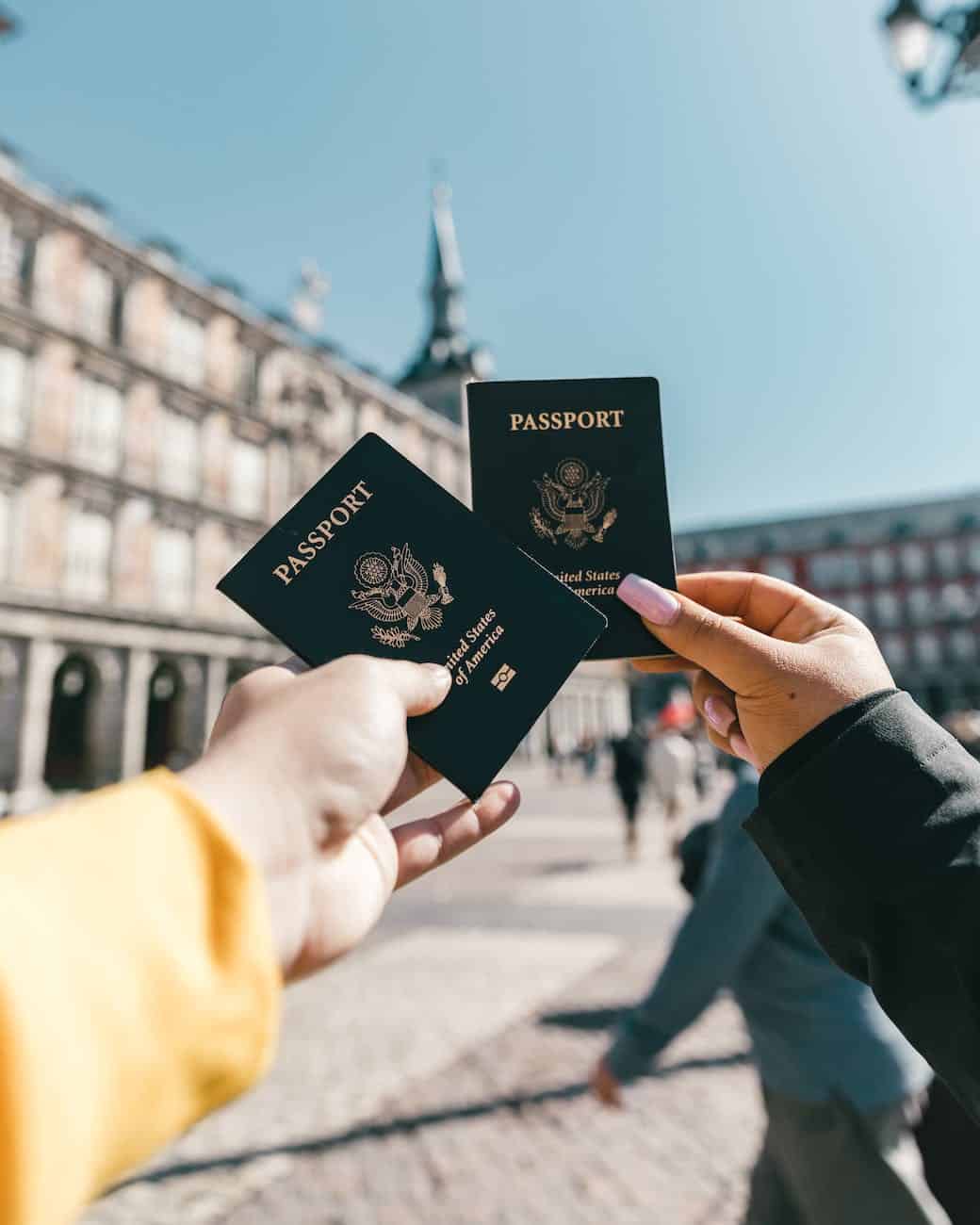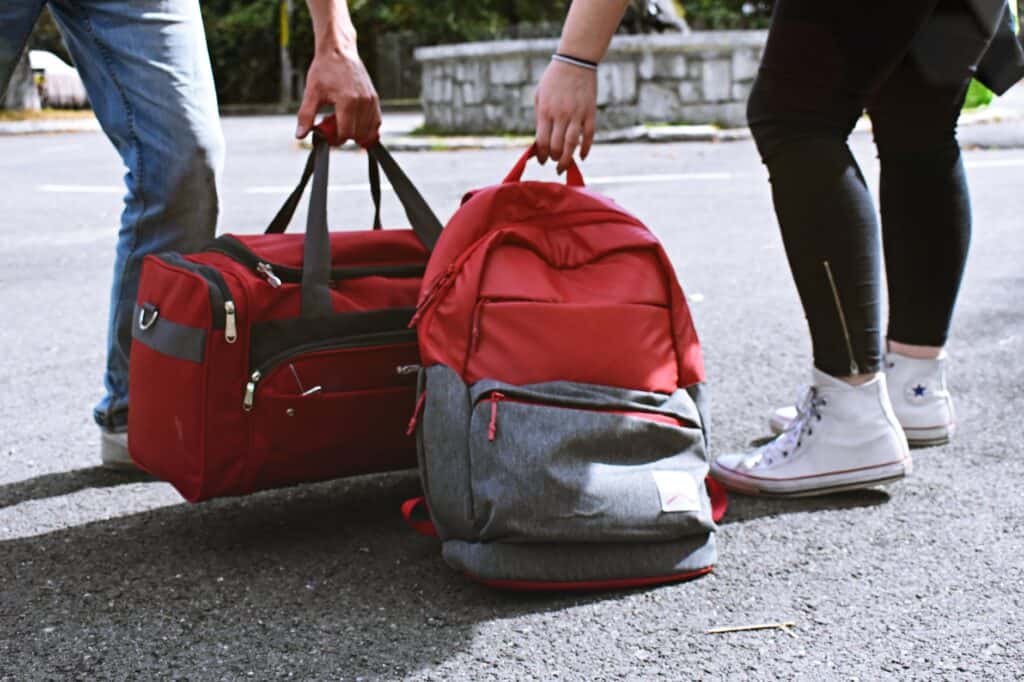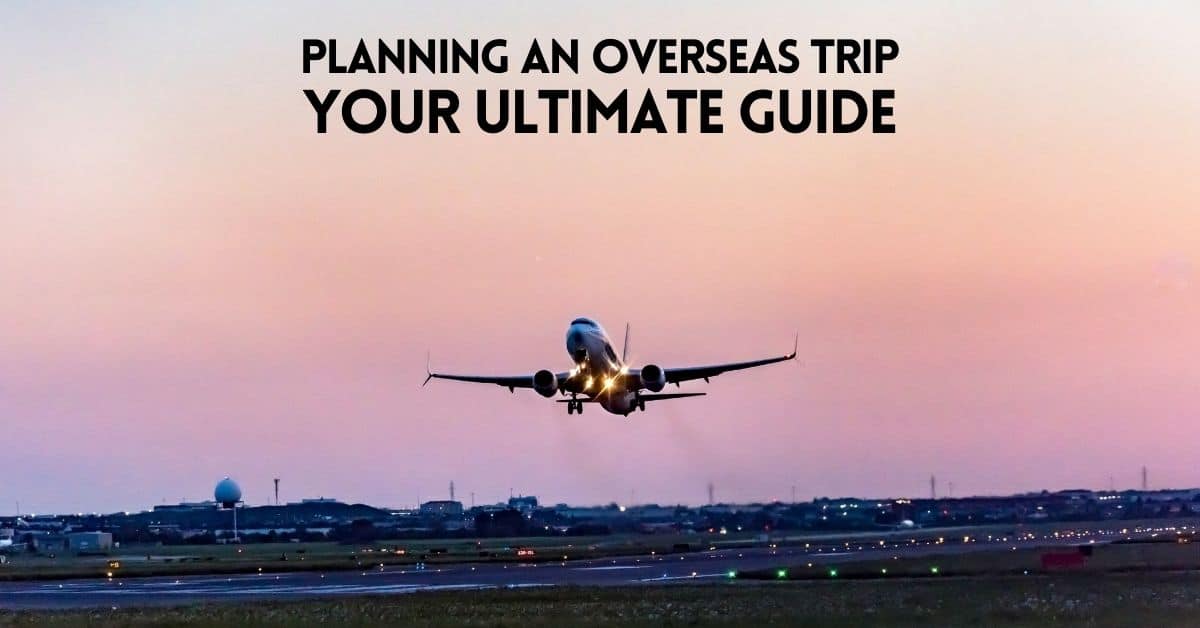Planning an Overseas Trip? Here’s What You Should Do
Preparing for an overseas trip is an exciting but daunting task. From deciding where to stay to understanding which currency to use, much work goes into planning for the perfect trip abroad. With many trips under our belts outside our home country of the United States, we’ve compiled many top travel tips on traveling outside your home country.
We will cover various tried-and-true tips to help you ensure you have everything taken care of before you jet off on your journey. It’s our ultimate guide to planning an overseas trip.
The Places Where We Go contains affiliate links and is a member of the Amazon Services LLC Associates Program. As an Amazon Associate, we earn from qualifying purchases at no extra cost to you when you purchase using one of these Amazon links. Read our disclaimer and privacy policy for more information.

Planning an overseas trip
Travel Documents
Passport
If you travel out of the country, ensuring a valid passport is a priority. You may need this document when you’re booking your flight. We encountered this situation ourselves recently.
If you don’t have a passport, give yourself plenty of time (at least three months) to obtain one. If you have less time to arrange for a passport, some services can expedite getting a passport in just a few days. We had done this many years ago. It will cost money. Still, you’re much better off not waiting until it’s too close to a planned trip to arrange for a passport.
If you have a passport, don’t assume it is still valid. Passports can be valid for ten years. That makes it easy to believe your passport is still good, but you don’t want to be surprised to learn it is too close to a renewal date.
Many countries require that your passport expiration is at least six months after the date you plan to leave the destination country. So, as an example, let’s say you want to travel somewhere next July, and your passport expires just a couple of months later in September. Authorities might deny your entry into a country if your passport has less than six months of validity on your passport.
In addition to having a valid passport, be sure to check that you have free pages left in your passport for immigration stamps.
Visa
Next, you’ll want to check if your destination country requires a valid visa.
United States and United Kingdom passport holders can travel to many countries without a visa and, in some cases, obtain a visa upon arrival. However, it’s best to do your homework on visas before your trip – and prepare as your destination country requires.
If you need a visa, be prepared to wait a month or more. And be sure that it will be valid for your stay.
Child Consent Form
If a child travels internationally with only one parent or a non-parent adult, the immigration officer may ask to see a Letter of Consent. The Minor Travel Consent Form has become more common as child abductions, custody cases, and human trafficking have risen.
International Drivers License
If you plan to drive outside your home country, you’ll want to arrange for an International Driving Permit (IDP). For United States drivers, permits are available through the American Automobile Association. The International Driving Permit is typically valid for one year and requires an annual renewal.
U.S. residents who are members of the American Automobile Association (AAA) can also get information and assistance in obtaining an International Drivers License through their offices.
Click for link to check International Drivers License (IDP) requirements
Expiration Dates – Travel Documents
In addition to your passport, check the expiration date on your other forms of identification – including your driver’s license (both domestic and international) and other documents subject to renewals.
Vaccination Documentation
Over the past few years, we’ve become accustomed to understanding that many places require COVID vaccination proof.
In addition to COVID, certain countries also require immunization against specific diseases. The most common on this list are vaccinations against yellow fever, malaria, meningococcal disease, and polio are most common on this list.
You’ll want to know what vaccines, if any, are required and how soon before your arrival to get the vaccine. Certain vaccines are required within a few weeks of your arrival. And if you need multiple shots with a few days in between, you’ll want to schedule these accordingly.
Keep records of your vaccinations and be prepared to show an official International Certificate of Vaccination, also known as a “yellow health card,” when traveling.
You can learn about vaccination requirements by visiting the CDC website.

Planning an overseas trip
Itinerary Planning
The fun part – trip planning and developing your itinerary. Once you’ve selected where you want to go, you’ll want to plan for several other things:
Length of your trip – we say, if paying for a flight, get as much time as you can from that investment
Must-see locations (for you). Identify the places you want to visit and activities you want to do during your travel. And check if the place you want to visit is open on the day you plan to visit. For example, many museums in Europe are closed on Mondays.
Sources – we use TripAdvisor and Atlas Obscura. Today, even a growing number of AI tools can help you craft a personal itinerary. If you use one of these, we suggest you double-check the validity of the output. Our experience is that it’s common for fine-tuning to be required when using AI.
If you enjoy pre-packaged tours, companies like Viator and Get-Your-Guide are great sources to book structured experiences.
If traveling over multiple time zones, plan a light schedule for your first day to allow you to acclimate.
We also will check crime statistics for the area we are considering visiting – this can help decide if you want to go to a place in the current environment or where you may wish to stay or avoid staying.
U.S. Citizens can register with the State Department’s Smart Traveler Enrollment Program or STEP. It’s a free program that provides safety updates and puts you in contact with local embassies and consulates in an emergency.
Plan only a few things per day – leave time for travel from one destination to another, and plan buffer time for unforeseen circumstances.
Buy advance tickets for popular attractions.
Many destinations offer city passes which provide discounts on attractions and transportation.
Planning dates – check your calendar to see if there are dates you want to avoid being away from home (e.g., special family events, etc.)
Check with your country’s embassy for any travel advisories on the destinations you’ll be visiting.
Itinerary Documentation
It’s a good idea to have backup copies of essential travel documents.
Email a copy of your itinerary to yourself and a loved one.
Your phone is one place to keep such copies as photos, images, or PDF documents. Consider adding copies of your passport pages, visa, personal identification, travel itinerary, airline and transportation info, birth certificates, and tickets purchased for tours and events.
You’ll have another way to access your information if you set up your copies on the cloud using a service like DropBox or Google Docs. We always travel with our itinerary stored in Google Docs – so much easier than the old-school paper copy method – though we still sometimes bring print-outs too.
Store Google off-line maps on your phone for places you plan to visit.
Transportation
Plan how you will get from the airport to your hotel and from every train station to your hotel if planning multiple cities. This includes how you’ll get from your home to your initial airport and what you’ll do to store your vehicle.
In Los Angeles, we have a place called The Flyaway, where we could leave our vehicle for $6 per day. Plus, The Flyaway offers reasonable shuttle services from their location to Los Angeles International Airport. Explore if you have similar services available near your home.
Become familiar with websites such as Rome2Rio – it’s an excellent tool for learning about route options in other parts of the world. We’ve used this in Europe to plan public transportation routes on trains, subways, and more. It’s also helpful for planning your transportation budget.
If you plan on driving at your international destination, review rental car options. Check out our post on Essential Rental Car Tips.

Planning an overseas trip
Financial Information
Whether you’re funding the trip of a lifetime or seeking how to construct a budget travel adventure, we all need to pay attention to the cost of our holidays.
Check for points from your credit card and travel companies (e.g., Expedia, airlines, and hotel plans) for opportunities to save money. We used points from a credit card to pay for a 2-week European cruise fully.
Please keep in mind your credit limit – and how much is unused. It can be a shock to land in a foreign country and find out on day one that your credit card has passed its limit. (How do we know this? It was our first major learning moment over three decades ago in international travel).
These days, you don’t necessarily need the currency of the country where you’re going. We just did one month in Europe and paid over 90% of our expenses by clicking Apple Pay on our cell phones.
Call your credit card company to advise where you’re going and when. We’ve had our credit card frozen on our first day of international travel when our credit card company didn’t know it was us traveling out of the country.
Also, check to see what benefits your credit card offers for travel. Travel credit cards are known for their features that suit people who love to travel. For example, the Chase Sapphire Credit Card offers travelers many benefits. For instance, your card may offer travel insurance, ATM fee waivers for ATM transactions, rental car coverage, and more.
Not all countries offer easy access to ATMs. However, electronic financial instruments are changing – rapidly.
Before you leave, pay upcoming bills in advance. Also, consider setting up automatic payments where possible.
Travel Insurance
If you are making a significant investment in a trip and there is any chance that something can disrupt your plans, consider travel insurance. The overall cost and investment can be substantial for international trips, so we nearly always use travel insurance once we devote several thousand dollars to an upcoming vacation plan.
Check if your credit card offers any travel insurance. And if using a travel agent, double check if they’ve added travel insurance before booking your own.
We use World Nomads as our travel insurance provider.
Airline Cost and Air Travel Tips
When booking your flight, check if you have points available to use for saving money. Use websites like Expedia or Google Flights to research cheap flights if saving money is a personal criterion of importance. And don’t forget to select seats shortly after you book your flight; otherwise, you might not get to sit where you’d like.
Check the airline website for your reservation before your trip. On our recent Europe trip, we received no communication from the airlines. Still, upon randomly accessing our reservations through their portal online, we came across quite a few documentation requirements that were being requested before our travels.
Seat Reservations: Many of us have particular places we prefer to sit on an airplane. It might be a window seat, while others want the aisle. Some choose the rear of the plane, while others want to be in an exit row or the first row of a section in the aircraft. If you have seat preferences, log into your airline’s portal to reserve your seat selection. When using an aggregator like Expedia, this often is an extra step you’ll need to do separately from booking the flight ticket.
Layover: We purposely book long flights to include layovers. Generally, we like to break up our international flights with a stop midway. As a benefit, we can stretch our legs and get better food than we’ll typically encounter on the plane ride (if any food is served at all). Plus, you’ll find that layover flights cost less than direct flights.
Hotel Cost
Consider if your connections will be direct from a transportation center to hotels or if you’ll end up walking with your packed items during portions of your trip.
For example, we. or hotels by quality (8.5+ on Expedia), then by walking distance from tube stops, first searched from lodging to places we were likely to visit (as we would rely on public transportation). Our last filter to book accommodation is for price.
We used our new Chase Sapphire Credit Card points on a recent UK trip to cover five nights in London.
Chase Sapphire Preferred – Earn 60,000 bonus points after you spend $4,000 on purchases in the first 3 months from account opening. Click to learn about the current promotion offered by Chase.

Planning an overseas trip
Packing
Make a packing list of essential items. Take inventory of what you have well before your trip. Purchase any items you don’t have.
We recommend packing early to minimize the stress of procrastination, especially before an extended overseas trip.
A few other things that proved helpful in our overseas international travel:
Compression socks – Compression socks are touted as a great way to ease the discomfort associated with long flights. Not only do they provide extra comfort, but they also help promote circulation and reduce the risk of deep vein thrombosis. Compression socks can be especially beneficial if you have an extended layover between flights, as sitting for longer can lead to swelling and discomfort in the lower legs. If you are prone to swollen ankles or feet, they can help reduce swelling and relieve aching muscles. Investing in a good pair of compression socks before your next trip can help make it more comfortable and enjoyable.
Hiking/Travel pants – with lots of pockets
Walking shoes that would work well on cobblestone streets (Europe) – know your terrain
TSA locks for luggage
Travel Cubes – these great organizers save space and are a great way to pack many clothes into small spaces.
Planning an overseas trip
Weather
You can Google for average temperatures during the time of your vacation. For example, don’t assume it will be warm in your destination just because it’s summer. We experienced cool weather and rain on our summer trips to Alaska, Montana, and European countries in the Baltics and Scandinavia – even during the summer months.
Medical
Do your research on handling medical situations out of the country if needed. Check with your medical insurance provider to understand how to cover situations if they arise out of the country.
Medications – ensure you have enough for your trip and carry a copy of your prescription.
Carry your medication on your person (versus storing it in luggage on the plane) in case luggage gets lost.
If you are under special care or receiving special treatment, carry copies of medical records if you need medical attention while traveling.
In Europe, we do a lot of walking, averaging nearly 24,000 steps daily. That can place a lot of wear and tear on the feet. We find having moleskin is extremely helpful when our feet start having issues. Keep some with your packing supplies.
Communication
Language Preparation – it’s helpful to learn some basic phrases when traveling to a country where people speak a different language. We’re big fans of Duolingo.
Emergency contacts listings – have phone numbers available (and not just on your phone – just in case it gets lost or stolen).
Travel with contact information for financial institutions, travel agents, hotels, etc.
International Cell Phone Service – Check with your mobile phone provider to see what arrangements will be needed for you to use your phone when traveling internationally. For our Verizon Wireless plan, we paid $100/month per phone to stay connected with our cell phones during international travel. Some people rely only on wifi to stay connected with people back home, and that is another option.
VPN – some websites and social media apps are blocked in certain countries. So using a VPN can help you access sites and protect your information online.
Smart Phone apps – review helpful apps for your travel – for example, transportation apps popular in your destination country
Technology
Noise-canceling headphones are fabulous on long flights. We travel with Bose QuietComfort headphones.
Battery charging packs – consider getting one or more for access to power if you’ll have long days exploring.
Electric adaptors – you may need a variety of adapters when visiting countries other than your own. Expect electrical outlets to take a different type of plug than you use at home.
If you plan to use devices on an airplane, ensure your cables are of the standard USB type on one end. On our recent trip, I brought my super go-fast iPhone charger and didn’t catch that the end of the cable was USB-C. The airplanes we traveled on did not offer this type of connection.
Confirm charging is activated – We’ve had this experience too many times at airports. We find charging stations and plug in our devices to catch up on email or do some work. Only later do we see our battery level going down because the charging stations at the airport are not supplying any power. So our tip here is when plugging in your devices at airports and anywhere during your travel, take a moment to confirm that charging is occurring.

Planning an overseas trip
Photography
Photo gear can take up space – so plan what you’ll want to bring. On many trips, we might only use our iPhones and a GoPro. Sometimes we’ll bring a small point-and-shoot. We have one that works underwater for destinations like Mexico and the Caribbean.
We have a Nikon SLR that takes excellent stills – especially in low light. It’s hit-and-miss if we bring this – though leaning more toward including it at least with a 35mm lens for future trips. If you bring an SLR or mirrorless camera, then also do some research on what lenses will be best for your getaway. You’ll choose differently if going to Africa on Safari adventures versus exploring ancient churches in Rome.
For our recent month-long international trip, I got by with my iPhone on the belt and my GoPro in my pocket. In retrospect, I could have also brought along the Nikon DSLR – however, knowing our time in the Baltic region was likely to have quite a bit of rain, I decided to leave that camera at home. I’ll not be making that same decision, though, for future trips.
Prepare Your Home For Departure
This was the topic of our Episode 98 podcast.
Download our free “Prepare Your House For Vacation Checklist” and reference it before future travel adventures.
Prepare Yourself For Departure
Jet Lag Adjustment – We aim to adjust our sleep about two weeks before our travels. This helps us be up and running when we land in our destination country.
Indulge Yourself – Julie makes an appointment at the nail salon to get a special nail treatment before our big international trips and cruises. It adds to the special feeling that accompanies the excitement of travel. When she comes home with colorful nails, that often indicates the next big trip is imminent.
Pack Food – These days, you’re likely to encounter cross-country flights where you are not served a meal; food at airports can be pricy. You might even have special dietary restrictions. We recommend bringing snacks and even some prepared food for your long flights. Our appetites have been saved with Clif Bars, trail mix, homemade wraps, etc.
Planning an overseas trip
Frequently Asked Questions – FAQ
We recommend planning most trips up to 12 months in advance, especially if you will be traveling during the peak season (summer months). The further in advance you plan, the more time you’ll have to research money-saving opportunities, get tickets for popular activities, and ensure all documentation is in order. Additionally, it is always wise to purchase trip insurance in case any unexpected issues arise during your journey.
The best time to book international travel is usually during the off-season. This is typically in late fall and winter when prices are at their lowest but availability of flights, accommodation, and attractions may be more limited. It’s also a good idea to watch for special offers or discounts that airlines may offer throughout the year. You can almost always find a great deal by being flexible with dates and shopping around. Book your flights a few months in advance for even better prices.
Also, consider booking during shoulder seasons (spring or fall) when prices may be lower than peak season, but the weather might still be pleasant. You’ll also have more choice of where to go as many popular destinations may be less crowded during these periods. Careful planning and research can help you find the perfect balance between price, availability, and weather conditions!
The best time to book an international flight is usually 6-8 weeks before the departure date. This window allows travelers to find flights with competitive airfares while giving them enough time to plan their trip and make necessary arrangements.
More tips to help you find good deals include subscribing to email updates, using comparison sites, and booking one-way flights instead of roundtrip. Please remember that prices for international flights can change significantly within a short period, so it’s essential to act quickly once you find a good deal.
The short answer is it depends. Travel agents can access exclusive deals and discounts that you may not find if you book directly with the airline. They also have experience finding the best possible combination of flights at competitive prices. Ultimately, booking through a travel agent may help you save money on international flights if they can get you a better deal than what’s available. Additionally, if something goes wrong with your flight, a travel agent can often help sort it out more quickly than if you contact the airline directly.
If you have time to research, it’s worth shopping around and comparing prices before you decide. While booking through a travel agent may not necessarily be cheaper in all cases, they may offer other benefits that make it a worthwhile option.
Closing Thoughts for Planning an Overseas Trip
Be flexible and have a positive and open mindset. The longer you are away, the more likely that only some things will go 100% to plan. Be prepared to go with the flow. Mindset matters.
Traveling overseas can be exciting – but there can be lots to think about and do. Just do your homework and plan well in advance, so you can give yourself time to unload the stresses as you get closer to your adventure.
Podcast Episode – Planning an Overseas Trip
Thanks for reading. We hope to see you at the places where we go!
Julie & Art
#travelplanning
More Travel Tips
Stopovers versus Layovers – Planning Guide for Airline Trips
Pin it for later
Fuel your wanderlust with weekly travel updates – It’s 100% FREE!


3 Comments
Comments are closed.